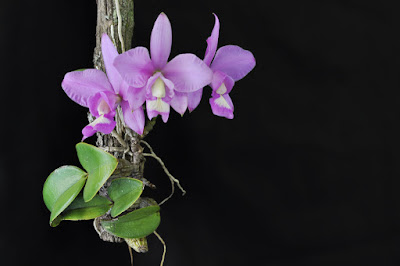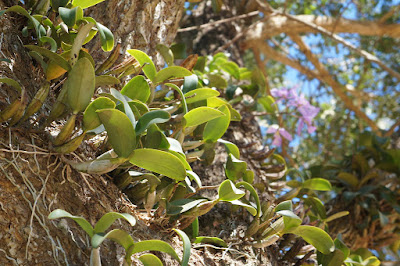Cattleya nobilior occurs in Brazil, Bolivia and Paraguay, where it grows epiphytic in trees along rivers on rough barked trees at the edges of high cliffs at an altitude of 170 to 700 meters above sea level...
Cattleya nobilior also called as The Noble Cattleya, Cattleya nobilior f. alba, Cattleya nobilior f. amaliae, Cattleya nobilior f. hugueneyi, Cattleya nobilior var. alba, Cattleya nobilior var. amaliae, Cattleya nobilior var. hugueneyi, Cattleya nobilor var. amaliae, Cattleya walkeriana var nobilior, is a species of the genus Cattleya. This species was described by Heinrich Gustav Reichenbach in 1883.
IDENTIFY CATTLEYA NOBICOLOR ORCHID PLANT
Cattleya nobilior occurs in Brazil, Bolivia and Paraguay, where it grows epiphytic in trees along rivers on rough barked trees at the edges of high cliffs at an altitude of 170 to 700 meters above sea level.
It is a small to medium sized, hot to warm growing epiphyte with ellipsoid, 5-8 cm in length and 2.5-3 cm in width pseudobulbs carrying 2 apical, elliptic to elliptic-oblong, coriaceous, about 8 cm in length and about 5 cm in width leaves.
The Noble Cattleya blooms on a to 8 cm long, slender, 1 to few flowered inflorescence with up to 5 extremely fragrant flowers. The flowers with light carmine-red shade, are about 12 cm in diameter. Sepals elongated-lanceolate, upper crescent, measuring 6-7 cm long and 1.8-2.3 cm wide. Petals are ovate, tapering to the base, measuring 5.5-7 cm long and 4-5 cm wide. The lip is triple, in the form of a violin, its lateral parts are larger than the front, and cover the column inside; the front part is elliptical, carmine-red, with a diamond-shaped (less often in the form of a heart) yellow spot in the middle, the total size of the lip is about 5.8-7.2 cm long and 5.2-6.4 cm wide. The column is about 2.8 cm long.
CATTLEYA NOBICOLOR ORCHID PLANT CARE AND CULTURE
Cultural information should only be used as a guide, and should be to be adapted to suit you. Your physical location; where you grow your plants, how much time you have to devote to their care, and many other factors, will need to be taken into account. Only then can you decide on the cultural methods that best suit you and your plants.
Light:
Cattleya nobilior can tolerate a direct midday sun of 50000-70000 lux, acquiring a lighter shade of leaves and pseudobulbs, dark colors can blush. Sunlight should not only be bright, but also constant throughout the year. The way out of the situation is the installation of artificial light lamps over plants for the period from the end of September to April. The total duration of a light day should be at least 12-16 hours, otherwise the orchid may simply not bloom.
Temperature:
Since then no matter what will day temperature, it is important to keep night temperature not above 24 ° C, ideally 16-18 ° C . The colder it will be at night (but not below 16 ° C), the more carbon will be collected, and the better the orchid will grow and regularly bloom.
Humidity:
During the rainy season, the air humidity does not drop below 70%, and during the drought in the daytime it can reach 20-30%, however, at night it rises again, due to which in the mornings there is abundant dew. In conditions of high humidity, it is necessary to regularly ventilate the room where the plants are kept, since wet, stale air is an ideal medium for the mass reproduction of various fungal and bacterial diseases.
Substrate, growing media and repotting:
Cattleya nobilior can be placed on block or grow in small clay or plastic pots of light tones or suspended baskets. The substrate must be very well breathable, therefore the mixture of the bark of coniferous trees with charcoal and sphagnum moss (30-35%) is best in its quality. In this case, it is recommended to lay the moss on the surface of the substrate.
Repotting is desirable only when it is really necessary. For example: If you water it with ordinary tap water, the pH of which is between 7.2 and 7.8, then over time, as a rule, for 2 years, a favorable pH of the substrate (5.5 to 6.5) also will jump to this index, and the orchid will not be able to absorb more useful substances, which means that it will start to lose its color in the leaves - yellow.
Watering:
The frequency and abundance of watering the orchids of this species directly depends on the intensity of the light and the overall temperature of the content, the higher they are, the more often and more abundantly need to be watered. Watering should be organized in such a way that the roots of the actively growing are always wet. The substrate between waterings should dry well, but no more than 12 hours is completely dry.
Fertilizer:
During the period of active growth, this type of orchids is fertilized every 1-2 weeks in 1/4 of the fertilizer concentration indicated on the package. In addition to the usual root dressing, it is also possible to produce a foliar dressing, when the outermost part of the plant is sprayed with a very diluted fertilizer. It is best to feed the orchid, alternating both these methods. The best fertilizer is fertilizer containing nitrogen, phosphorus and potassium in equal parts, for example, NPK = 3-3-3 or 8-8-8. If you do not have such fertilizer, at the beginning of the growing season, feed the orchid with fertilizer with a high nitrogen content, and by the time of the formation of new pseudobulbs - with a high content of phosphorus.
Rest period:
Cattleya nobilior needs a period of rest last from November through March. In this period, the daytime temperature is at below 24 ° C, only the nights become colder to 10-15 ° C, the amount of water should be reduced, and stop fertilizer. Refusal of flowering can be caused by insufficient lighting, too hot nighttime maintenance or the general stress state of the orchid, for example, with a poor root system.















COMMENTS